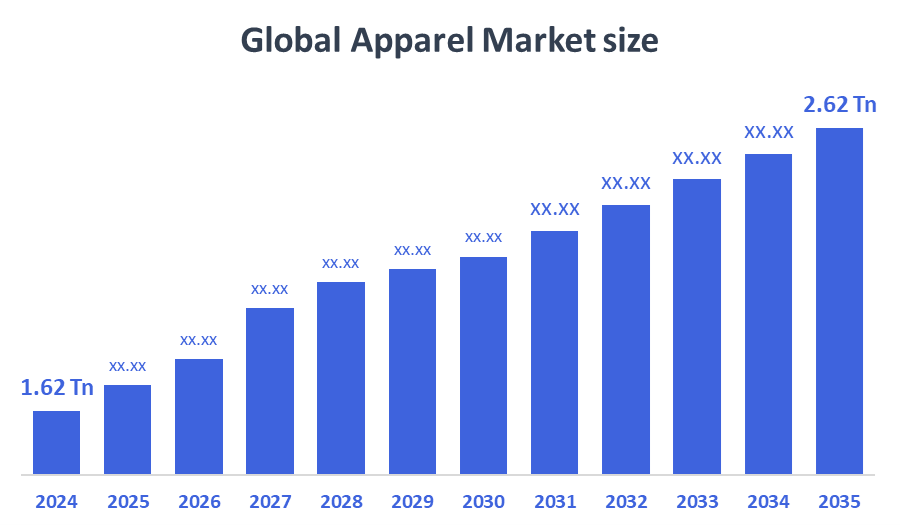Global Apparel Market
Global Apparel Market Size, Share, and COVID-19 Impact Analysis, By Category (Mass, Premium, Luxury), By End Use (Men, Women, Children), and By Region (North America, Europe, Asia-Pacific, Latin America, Middle East, and Africa), Analysis and Forecast 2025 - 2035
Report Overview
Table of Contents
Apparel Market Summary
The Global Apparel Market Size Was Valued at USD 1.62 Trillion in 2024 and is Projected to Reach USD 2.62 Trillion by 2035, Growing at a CAGR of 4.47% from 2025 to 2035. Rising disposable incomes, changing fashion trends, urbanization, more e-commerce, and growing brand awareness are the main factors propelling the apparel market's rise. Furthermore, demand for eco-friendly and practical apparel supports the market's ongoing growth in all worldwide areas.

Key Regional and Segment-Wise Insights
- In 2024, the Asia Pacific held the largest revenue share of over 39.3% and dominated the market globally.
- In 2024, the mass segment had the highest market share by category, accounting for 67.5%.
- In 2024, the women segment had the biggest market share by end use.
Global Market Forecast and Revenue Outlook
- 2024 Market Size: USD 1.62 Trillion
- 2035 Projected Market Size: USD 2.62 Trillion
- CAGR (2025-2035): 4.47%
- Asia Pacific: Largest market in 2024
The apparel market encompasses all aspects of clothing development, manufacturing, distribution, and retail sales for men, women, and children. The market extends across multiple product segments, which include sportswear alongside formal wear, casual clothing, and fashion merchandise. Urbanization, increased fashion understanding, and higher disposable income levels serve as the primary market growth drivers. The rising influence of social media, combined with rapidly changing fashion trends and evolving lifestyles, has elevated consumer interest in fashionable, diverse clothing options. Market expansion occurs mainly because more people join the workforce while developing a preference for comfortable, branded clothing. E-commerce platforms serve as a crucial market component since they deliver affordable prices to customers, together with extensive product choices and simple shopping experiences.
The apparel market has changed as a result of technological improvements that have increased production efficiency, improved product quality, and allowed for innovation. Technologies that streamline processes and shorten time-to-market include automated manufacturing, 3D printing, virtual fitting rooms, and AI-driven design. Additionally, wearable technology and smart fabrics are becoming popular. The industry is receiving support from governments across the globe through programs that encourage local manufacture, talent development, and environmental practices. The clothing sector is being further strengthened by policies that support digitalization, export incentives, and environmentally responsible production, which will make it more resilient and prepared for the future.
Category Insight

With the biggest revenue share of 67.5% in 2024, the mass category dominated the worldwide apparel market. The affordability, broad accessibility, and strong consumer demand in both established and emerging nations are the main factors driving this segment's impressive performance. Mass-market apparel caters to a broad audience with budget-friendly, trend-responsive clothing, making it the most popular choice for everyday wear. Fast fashion brands, which rapidly produce trendy items at low costs, play a major role in fueling this segment’s growth. Additionally, the rise of e-commerce and global retail chains has made mass-produced apparel more accessible than ever. The segment benefits from economies of scale, efficient supply chains, and continuous demand, ensuring its leading position in the industry.
Throughout the projected period, the luxury segment of the global apparel market is anticipated to grow at the fastest rate due to factors like growing disposable incomes, growing brand awareness, and rising demand for high-end, premium clothes. Luxury fashion is becoming more and more popular among consumers, especially in emerging nations, as a status and lifestyle symbol. The growing popularity of global premium brands, individualized shopping experiences, and unique product offerings are additional advantages for this market. Customer engagement is being further improved via digital innovation, such as AI-driven customisation and virtual showrooms. Additionally, younger consumers, particularly millennials and Gen Z, are demonstrating a strong desire for luxury brands that share principles like ethical production and sustainability, which is driving the market's continuous expansion in this upscale clothing sector.
End Use Insight
The global apparel market is dominated by the women's segment, by holding the largest revenue share during 2024, because women purchase clothing at a higher rate and require more diverse fashion options than other end-use sectors. The diverse nature of women's clothing includes formal attire alongside ethnic clothing, sportswear, and casual and high-end fashion pieces to match different tastes and fast-changing trends. The growing influence of social media, along with celebrity endorsements and fashion influencers, has significantly shaped women's fashion choices, leading to increased market demand. The combination of increasing female workforce participation and rising disposable income has led to higher spending on both lifestyle and business attire. The worldwide women's clothing market growth has been accelerated through the development of e-commerce platforms, which also provide easier access to fashion.
Over the course of the forecast period, the children's segment of the global apparel market is anticipated to grow at the fastest rate. Rising birth rates in developing nations, parents' increased spending on stylish and high-quality clothes for their kids, and the expanding impact of social media and kids' fashion trends are the main drivers of this expansion. Parents are eager to spend money on fashionable, cozy, and long-lasting clothes for their children as they grow increasingly brand-conscious. Sales are also being boosted by the demand for character-themed and licensed clothing, which is frequently influenced by well-known cartoons and films. Children's clothing has become a major area of attention for market participants due to the rapid growth of the segment, which is also being aided by the rise of internet shopping and specialty brands.
Regional Insights
In 2024, North America held a substantial revenue share of the worldwide apparel market due to its strong consumer base, combined with elevated disposable income levels and well-developed retail systems. A large number of leading fashion brands together with retail stores from different countries have their headquarters in this region, where they target customers across all market segments, from affordable to high-end. The way people shop continues to be affected by fast fashion trends alongside the increasing popularity of clothes produced through ethical and sustainable methods. Online shopping platforms combined with omnichannel retail strategies enable customers to obtain clothing products with greater ease and convenience. The North American apparel market continues to grow because of increasing popularity in casual and activewear, combined with fashion awareness among Gen Z and millennial consumers.
Europe Apparel Market Insights
Europe held a substantial revenue share of global apparel market throughout 2024 due to its thriving retail sector combined with wealthy consumer base and its rich fashion heritage. The territory possesses significant fashion capitals which determine worldwide style trends through Paris Milan and London. The European market demands sustainable products alongside high-quality items and trustworthy brand names so quick fashion and luxury companies must transform their business models. The rising interest in sustainable and environmentally friendly apparel is affecting consumer purchasing behaviors. The rise of e-commerce platforms and digital fashion services has made shopping more convenient and accessible for customers. The European apparel industry expands its market through government initiatives that support sustainable fashion and circular production methods.
Asia Pacific Apparel Market Insights
In 2024, the Asia Pacific region led the worldwide apparel market by generating the largest revenue share of 39.3%. The dominant market position of this region stems from its expanding population base, together with rising household incomes and increasing urbanization in China, India, Japan, and South Korea. The region functions as a major world manufacturing hub because of its affordable production costs and established textile supply network. The rapid growth of e-commerce, along with changing fashion preferences and Western cultural influence, drives demand for both budget-friendly and premium apparel products. The growth of middle-class populations and enhanced brand recognition have led to increased apparel consumption. The combined factors establish Asia Pacific as a major force behind the worldwide growth of the apparel market.
Key Apparel Companies:
The following are the leading companies in the apparel market. These companies collectively hold the largest market share and dictate industry trends.
- VF Corporation
- PVH Corp.
- Adidas AG
- Burberry Group plc
- LVMH
- Adidas AG
- NIKE Inc.
- KERING
- Puma SE
- INDITEX
- H & M Hennes & Mauritz AB
- Others
Recent Developments
- In March 2025, Together with TOGETHXR Inc., NIKE, Inc. introduced the Everyone Watches Women's Sports clothing line. The collection, which includes T-shirts, hoodies, and caps, reaffirms Nike's dedication to promoting women's sports via creativity, funding, increased awareness, and motivation.
- In November 2024, In Singapore, Burberry set up shop at the Wisma Aria mall. It opened with Burberry spring collection 2025, with inspiration from outdoor and element of effortless elegance.
Market Segment
This study forecasts revenue at global, regional, and country levels from 2020 to 2035. Decision Advisors has segmented the apparel market based on the below-mentioned segments:
Global Apparel Market, By Category
- Mass
- Premium
- Luxury
Global Apparel Market, By End Use
- Men
- Women
- Children
Global Apparel Market, By Regional Analysis
- North America
- US
- Canada
- Mexico
- Europe
- Germany
- UK
- France
- Italy
- Spain
- Russia
- Rest of Europe
- Asia Pacific
- China
- Japan
- India
- South Korea
- Australia
- Rest of Asia Pacific
- South America
- Brazil
- Argentina
- Rest of South America
- Middle East & Africa
- UAE
- Saudi Arabia
- Qatar
- South Africa
- Rest of the Middle East & Africa
Check Licence
Choose the plan that fits you best: Single User, Multi-User, or Enterprise solutions tailored for your needs.
We Have You Covered
- 24/7 Analyst Support
- Clients Across the Globe
- Tailored Insights
- Technology Tracking
- Competitive Intelligence
- Custom Research
- Syndicated Market Studies
- Market Overview
- Market Segmentation
- Growth Drivers
- Market Opportunities
- Regulatory Insights
- Innovation & Sustainability
Report Details
| Pages | 145 |
| Delivery | PDF & Excel via Email |
| Language | English |
| Release | Oct 2025 |
| Access | Download from this page |
